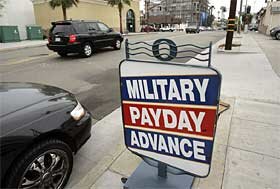Military Leaders Press California Legislature to Restrict Military Payday Loans
By J.J. CameronPayday Loan Writer
According to a story in the Union-Tribune, military leaders will press state legislators today to protect the hundreds of thousands of young and impressionable service members who are prime targets for payday loans, which often charge a maximum annual rate of 459 percent.

The armed forces' top commanders see military payday loans, in which consumers pay an upfront fee for an advance on their next paycheck, as an increasingly unpatriotic distraction from war operations.
Their reasoning? Service members are often financially unsophisticated, which makes it easier for them to fall into a cycle of debt. Such financial troubles are creating challenges for morale and other aspects of war readiness, the military brass said.
“We've had to remove sailors from sensitive positions handling millions of dollars' worth of equipment until their financial problems can be taken care of,” said Navy Capt. Mark Patton, a Point Loma Naval Base commander who will represent 90,000 sailors at today's hearing.
Cheap payday loans and other high-interest financial transactions are the subject of a joint Assembly and Senate hearing titled “Protecting Our Protectors: Confronting Consumer Scams Aimed at the Military.” Active-duty personnel are three times more likely than civilians to take out a payday loan, according to a 2005 report by the Center for Responsible Lending in Durham, N.C. It estimated that 225,000 service members nationwide had done so in 2004.
The number of payday loan lenders has exploded from fewer than 200 nationwide in 1990 to nearly 2,300 in California alone two years ago, said Christopher Peterson, a law professor at the University of Florida, and Cal State Northridge geography professor Steven Graves in a study last year. Many of these centers are located near military bases. The Oceanside area adjacent to Camp Pendleton has about 70 payday loan lenders, the highest concentration for any of the state's 1,661 ZIP codes.
In 2001, the Marine Corps Relief Society gave a total of about $5,800 to nine service members nationwide so they could pay off their debts stemming from payday loans. Last year, the group spent $987,000 on 1,509 such clients.
“I'm trying to drum up some righteous indignation,” said Maj. Gen. Mike R. Lehnert, commander of Camp Pendleton-based Marine Corps Installations West, which consists of 65,000 Marines and sailors at seven bases in California and Arizona. “Predatory payday lenders aiming at our military is shameful and should be stopped.”
The military payday loan industry says it provides a valuable and straightforward way for people to make ends meet. A spokesman for the California Financial Service Providers, which represents payday lenders and check cashers, said members obey the law and don't force anyone to use their services.
“We are a competitive product for consumers . . . that is both convenient and often times less expensive than other options, such as overdraft protection, late fees and interest charges on credit card debt,” said Greg Larsen, a spokesman for the providers group. “Our customer satisfaction level is very high.”
Patton, the captain at Point Loma Naval Base, strongly disagrees. He said it's no service to:
- Mask the annual percentage rate by charging an upfront “service fee” scaled to the dollar amount of a loan. For instance, customers might pay $15 for a two-week advance of $100. Taken as an annual percentage, that interest rate would be 390 percent.
- Allow simultaneous borrowing from multiple lenders. California law requires a faxless payday loan to be repaid before another is made, but there's no network to verify outstanding loans.
“There is no enemy that our Navy is more passionate about defeating than the one who targets our own sailors,” Patton said.
Most people who take payday advances are younger than 35, according to both independent studies and those commissioned by the payday loan industry. The biggest debt problems arise when the original loan isn't paid off and new loans are taken to cover the old ones, some of these surveys indicated.
In their study, titled “Predatory Lending and the Military: The Law and Geography of 'Payday' Loans in Military Towns,” professors Peterson and Graves found that:
- Last year, San Diego County had at least 238 payday loan centers. Its total was second only to Los Angeles County.
- The 459 percent maximum for payday lenders in California is typical nationwide. For the 20 states analyzed in the study, payday interest rates ranged from 364 percent to 550 percent.
- Even though payday advance lenders are a powerful special interest group, they can be regulated.
New York imposes a maximum annual percentage rate of 16 percent and makes it a felony to charge more than 25 percent. North Carolina, a military hub like Southern California, has banned payday loans and capped other small loans at 36 percent APR.
In San Diego County, Patton said, the Navy is in early negotiations with local banks and credit unions to find alternative ways for sailors to get short-term cash at much lower interest rates. While he and Lehnert, the Marine general, aren't counting on legislators to pass lending laws favoring the military, there already has been an unexpected shift in Sacramento.
On Friday, the California Department of Corporations announced that it would close a decade-old loophole for out-of-state lenders starting June 30. The agency, which exists largely to safeguard Californians from financial exploitation, chose this year to highlight its goal of protecting war-stressed military families from questionable monetary offers. It launched an awareness campaign about high-interest cash advance loans and created a hotline for service members to lodge complaints.

